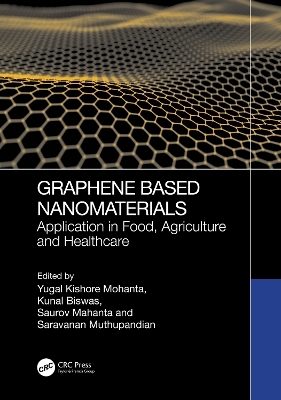
Graphene-Based Nanomaterials
CRC Press (Verlag)
978-1-032-29236-6 (ISBN)
The book presents a comprehensive overview of the historical, current, and prospective application realms of nanobiotechnological research pertaining to graphene, a carbon-based nanomaterial, and its diverse forms in the fields of food and agriculture, as well as health sciences and technology. Young nanotechnologists and businesses will have access to nanobioanalytical methods. Given the present circumstances, it is crucial to underscore the potential ramifications that diverse forms of graphene nanomaterials could have on the food sector, agricultural methodologies, and healthcare. This book presents an analysis of the potential advantages of graphene-based nanomaterials over traditional materials in the food, agriculture, and health care sectors.
This book employs case studies, academic and theoretical literature, technology transfer, innovation, economics, and policy management to underscore the intricate issues associated with graphene nanomaterials. The pioneering text Graphene-Based Nanomaterials: Application in Food, Agriculture, and Healthcare has the potential to serve as a valuable resource for interdisciplinary researchers, academics, practitioners, policymakers, and professionals operating within the fields of science, technology, engineering, innovation, management, and economics.
Features
· Discusses the different aspects of graphene as a two-dimensional material and its underlying unique physicochemical properties, synthesis methods, and protocols.
· Considers the implications of graphene in the food sciences and its different spoilage detection mechanisms have been encompassed in the book.
· Explores graphene nanomaterials' medical and biomedical uses. With examples, the unique and tailor-made material's uses and prospects in health sciences, pharmaceutics, and biomedical research are highlighted.
· Elaborates on graphene's applications in agriculture and briefs the potential of biocompatible planar conductive nanoscale materials to boost agri-product production, crop development, and crop-infection surveillance.
Yugal Kishore Mohanta presently works as an assistant professor and group leader of Nano-biotehnology and Translational Knowledge Laboratory at the Department of Applied Biology, University of Science and Technology Meghalaya, Ri-Bhoi, India. He earned a BS, an MS, and a PhD at North Orissa University, Odisha, India, and a postdoctorate at University of Nizwa, Sultanate of Oman. Kunal Biswas currently works as an assistant professor (research) at the Centre for Nanoscience & Nanotechnology, International Research Centre, Sathyabama Institute of Science and Technology (Deemed to be University), Jeppiaar Nagar, Rajiv Gandhi Salai, Chennai, India. He received his PhD from Maulana Abul Kalam Azad University of Technology (MAKAUT), West Bengal, India, and his master’s degree in nanoscience and technology from Tezpur Central University, Assam, India. Saravanan Muthupandian presently works as a professor in the AMR and Nanotherapeutics Lab, Department of Pharmacology, Saveetha University, Saveetha Institute of Medical and Technical Sciences (SIMATS), Chennai, India. He has over 21 years of teaching and research experience, and he is ranked in the top 2% of scientists worldwide by Stanford University in 2021 and 2022. Saurov Mahanta works for the National Institute of Electronics and Information Technology, Guwahati, under the Ministry of Electronics and Information Technology, Govt. of India. He received his master’s in molecular biology and biotechnology from Tezpur Central University, Assam, India and his PhD from Gauhati University, Assam, India.
SECTION 1: Graphene Nanoscale materials: Design, fabrication, utility, and unique properties
Chapter 1: Introduction to the graphene based nano-materials and its unique physico-chemical and electro-chemical properties
Chapter 2: Synthesis, Characterization and Applications of graphene-based Nanomaterials from a Nano-biotechnological Perspective
Chapter 3: Fabrication and designing of graphene-based nanomaterials using different current ‘top down’ and ‘bottom-up’ techniques.
Chapter 4: Graphene based nanomaterials as ‘biomaterials’ in stem cell differentiation, tissue regeneration and cell growth studies.
SECTION 2: Role of Graphene based nano-materials in Food & Agricultural biotechnology
Chapter 5: Implication of Graphene based nanomaterials in food applications.
Chapter 6: Effect of Graphene based nanomaterials in Agri-biotechnology
Chapter 7: Decorated/doped Graphene nanomaterials in augmentation of the food safety and quality employing recent trends
Chapter 8: Role of nano-composites using Graphene based materials for food/toxin sensing applications in agriculture
Chapter 9: Application of Green graphene-based nanomaterials in Agri-biotechnological sensors for surveillance and prevention of agricultural productivity
Chapter 10: Nano-encapsulation, nano-based formulations of graphene-based materials for plant growth fertilisers and nutrient enhancers
Chapter 11: Role and application of Graphene Nanomaterials in crop improvement or productivity enhancement of crops (through soil moisture conservation/disease control/ quality improvement)
SECTION 3: Graphene based nanomaterials in health care applications
Chapter 12: Nano-Bio interface: Graphene based Nanotechnology in targeted drug delivery applications
Chapter 13: Graphene based nanomaterials in myriad bioimaging applications in in-vitro and in-vivo studies
Chapter 14: Recent nanotechnological advancement of Graphene based nanomaterials in gene delivery or protein delivery
Chapter 15: Role of metal/ metal oxides decorated and doped Graphene nanosheets for biomedical applications
Chapter 16: Role of nano-composite(s) based upon Graphene/Biopolymer interface in Health care application
Chapter 17: Graphene based nano-materials as molecular disease theragnostic applications.
Chapter 18: Interfacing Graphene-Based Materials with Neural Cells/Brain transplants etc. for neuronal applications in health care
SECTION 4: Nano-Devices/ Biosensors in food, agriculture and health care with Computational Approaches
Chapter 19: Graphene nanomaterials-based sensors and its use in food industry, safety and packaging
Chapter 20: Recent advances in ultra-sensitive biosensor fabrication for agricultural pest detection and its future perspectives
Chapter 21: Graphene-based sensors for health monitoring and diagnosis using lab-on-chip and advanced computational approaches
Chapter 22: Emerging Graphene-based nanomaterials as DNA biosensor(s) using lab-on-chip, computational approaches and robotics
Section 5: Toxicity assessment of Graphene and its different forms (Safety, Health Evaluation (SHE)
Chapter 23: Evaluating the safety concentration of graphene-based nanomaterials on soil microbial diversity, micro-flora and micro-fauna pertaining to improved crop and agricultural practices.
| Erscheinungsdatum | 10.02.2024 |
|---|---|
| Zusatzinfo | 22 Tables, black and white; 90 Line drawings, black and white; 90 Illustrations, black and white |
| Verlagsort | London |
| Sprache | englisch |
| Maße | 178 x 254 mm |
| Gewicht | 811 g |
| Themenwelt | Technik ► Umwelttechnik / Biotechnologie |
| Weitere Fachgebiete ► Land- / Forstwirtschaft / Fischerei | |
| ISBN-10 | 1-032-29236-9 / 1032292369 |
| ISBN-13 | 978-1-032-29236-6 / 9781032292366 |
| Zustand | Neuware |
| Informationen gemäß Produktsicherheitsverordnung (GPSR) | |
| Haben Sie eine Frage zum Produkt? |
aus dem Bereich


